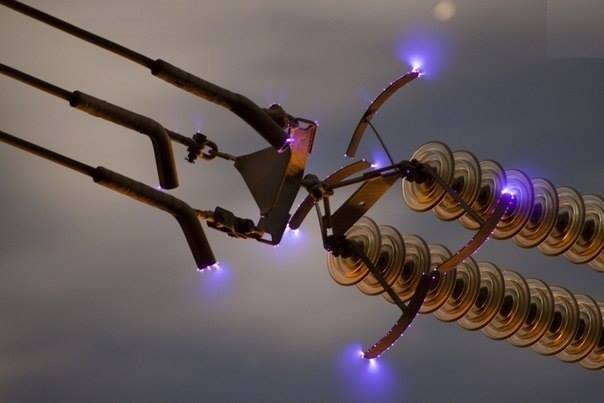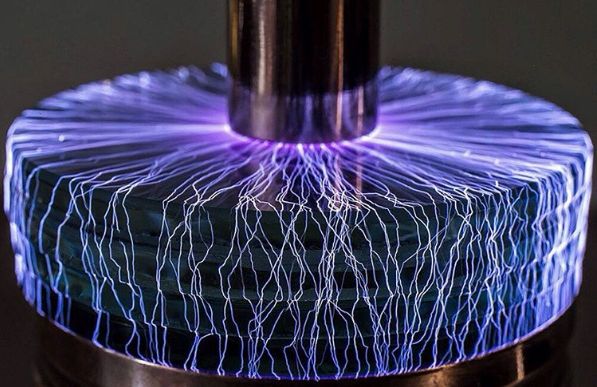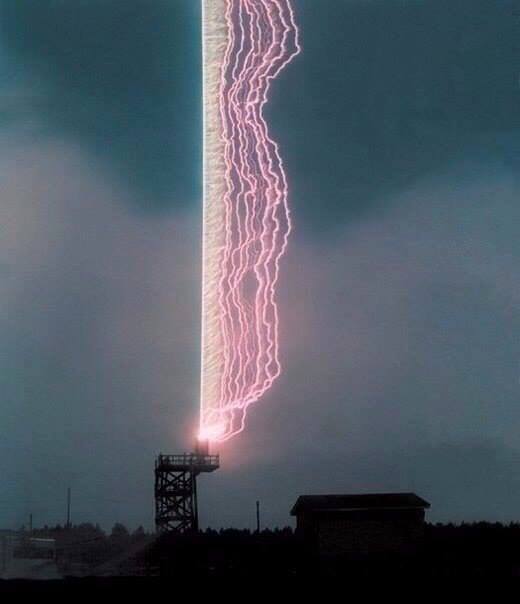Categories: Featured Articles » Interesting Facts
Number of views: 45063
Comments on the article: 2
Corona discharges or the lights of St. Elmo
 ... A large detachment of soldiers of Ancient Rome was on a night campaign. A thunderstorm was coming. And suddenly hundreds of bluish lights appeared over the detachment. It lit up the spears of spears of warriors. It seemed that the iron spears of the soldiers were burning without burning!
... A large detachment of soldiers of Ancient Rome was on a night campaign. A thunderstorm was coming. And suddenly hundreds of bluish lights appeared over the detachment. It lit up the spears of spears of warriors. It seemed that the iron spears of the soldiers were burning without burning!
Nobody knew the nature of the amazing phenomenon in those days, and the soldiers decided that such a radiance on the spears portends their victory. Then this phenomenon was called the lights of Castor and Pollux - after the mythological twin heroes. And later renamed the lights of Elma - the name of the church of St. Elmo in Italy, where they appeared.
Especially often, such lights were observed on the masts of ships. The Roman philosopher and writer Lucius Seneca said that during a thunderstorm "the stars seem to descend from the sky and land on the masts of the ships." Among the many stories about this, the evidence of the captain of an English sailing ship is interesting.
It happened in 1695, in the Mediterranean Sea, near the Balearic Islands, during a thunderstorm. Fearing the storm, the captain ordered the sails to be lowered. And then the sailors saw in different places of the ship more than thirty lights of Elm. On a vane of a large mast, the fire reached more than half a meter in height. The captain sent a sailor with an order to remove him. Going upstairs, he shouted that the fire hissed like a rocket from raw gunpowder. He was ordered to remove it along with a weather vane and bring it down. But as soon as the sailor took off the weather vane, the fire jumped to the end of the mast, from where it was impossible to remove it.
In 1902, the sailors of the Moravia steamboat saw an even more impressive picture. From the Cape Verde Islands, Captain Simpson wrote in a ship's logbook: “Lightning flashed for an hour in the sea. Steel ropes, mast tops, nokreys, cargo boom knocks - everything glowed. It seemed that every four feet on the dowels it seemed that they had lighted lamps, and at the ends of the masts and nocrays bright lights lit up. ” The glow was accompanied by an unusual noise:
“Like a myriad of cicadas settled in a snap, or dead wood and dry grass burned with a bang ...”
The lights of St. Elmo are diverse. They happen in the form of a uniform glow, in the form of separate flickering lights, torches. Sometimes they are so similar to flames that they rush to extinguish.
Humphrey, an American meteorologist who observed Elma’s lights at his ranch, testifies: this natural phenomenon, “transforming every bull into a monster with fiery horns, gives the impression of something supernatural.” This is said by a person who, by his very position, is not capable of seeming to be surprised at such things, but should accept them without unnecessary emotions, relying only on common sense.
We can safely say that now, despite the dominance - far from true, though not universal - of the natural scientific worldview, there will be people who, if they were in Humphrey's position, would see something in the fiery bull horns beyond reason. There is nothing to say about the Middle Ages: then, in the same horns, they would most likely see the machinations of Satan.

Corona discharge, electric corona, a type of glow discharge that occurs when there is a pronounced inhomogeneity of the electric field near one or both electrodes. Similar fields are formed at electrodes with a very large curvature of the surface (tips, thin wires). In Corona discharge, these electrodes are surrounded by a characteristic glow, also called the corona, or corona layer.
The non-luminous (“dark”) region of the interelectrode space adjacent to the corona is called the outer zone. The crown often appears on tall pointed objects (St. Elmo's lights), around wires of power lines, etc.The corona discharge can take place at various gas pressures in the discharge gap, but it manifests itself most clearly at pressures not lower than atmospheric.
The appearance of a corona discharge is explained by an ion avalanche. There are always a number of ions and electrons in a gas arising from random causes. However, their number is so small that gas practically does not conduct electricity.
With a sufficiently high field strength, the kinetic energy accumulated by the ion in the gap between the two collisions can become sufficient to ionize the neutral molecule during the collision. As a result, a new negative electron and a positively charged residue, an ion, are formed.
A free electron in collision with a neutral molecule splits it into an electron and a free positive ion. Electrons upon further collision with neutral molecules again splits them into electrons and free positive ions, etc.
Such an ionization process is called impact ionization, and the work that needs to be expended in order to detach an electron from an atom is called ionization work. The work of ionization depends on the structure of the atom and is therefore different for different gases.
The electrons and ions formed under the influence of impact ionization increase the number of charges in the gas, and in turn they come into motion under the influence of an electric field and can produce impact ionization of new atoms. Thus, the process strengthens itself, and ionization in the gas quickly reaches a very large value. The phenomenon is similar to a snow avalanche, therefore this process was called an ion avalanche.
We pull a metal wire ab having a diameter of several tenths of a millimeter on two high insulating supports and connect it to the negative pole of the generator, which produces a voltage of several thousand volts. We take the second pole of the generator to Earth. You get a kind of capacitor, the lining of which is the wire and walls of the room, which, of course, communicate with the Earth.
The field in this capacitor is very heterogeneous, and its tension near a thin wire is very high. Increasing the voltage gradually and observing the wire in the dark, one can notice that with a certain voltage, a weak glow (corona) appears near the wire, covering the wire from all sides; it is accompanied by a hissing sound and a slight crackle.
If a sensitive galvanometer is connected between the wire and the source, then with the appearance of a glow, the galvanometer shows a noticeable current flowing from the generator through the wires to the wire and from it through the room air to the walls, between the wire and the walls is transferred by ions formed in the room due to impact ionization.
Thus, the luminescence of air and the appearance of current indicate strong ionization of the air under the influence of an electric field. A corona discharge can occur not only near the wire, but also near the tip and generally near any electrodes near which a very strong inhomogeneous field is formed.

Corona discharge
Electric gas cleaning (electrostatic precipitators). A vessel filled with smoke suddenly becomes completely transparent if sharp metal electrodes connected to an electric machine are introduced into it, and all solid and liquid particles are deposited on the electrodes. The explanation of the experiment is as follows: as soon as the crown is ignited by the wire, the air inside the tube is strongly ionized. Gas ions adhere to dust particles and charge them. Since a strong electric field acts inside the tube, charged dust particles move under the influence of the field to the electrodes, where they settle.
Particle counters
The Geiger-Muller particle counter consists of a small metal cylinder equipped with a window covered with foil and a thin metal wire stretched along the axis of the cylinder and isolated from it.The meter is included in a circuit containing a current source whose voltage is equal to several thousand volts. The voltage is selected necessary for the appearance of a corona discharge inside the meter.
When a rapidly moving electron enters the counter, the latter ionizes the gas molecules inside the counter, which makes the voltage required to ignite the corona somewhat lower. A discharge occurs in the counter, and a weak short-term current appears in the circuit. To detect it, a very large resistance (several megaohms) is introduced into the circuit and a sensitive electrometer is connected in parallel with it. With each hit of a fast electron inside the counter, the electrometer leaf will be bent.
Such counters make it possible to register not only fast electrons, but also generally any charged, rapidly moving particles capable of producing ionization by collisions. Modern counters easily detect the ingress of even a single particle into them and therefore make it possible with full reliability and very great clarity to see that elementary charged particles really exist in nature.
Lightning conductor
It is estimated that in the atmosphere of the entire globe, about 1800 thunderstorms occur simultaneously, which give an average of about 100 lightnings per second. And although the likelihood of a lightning strike of an individual person is negligible, nevertheless, lightning does a lot of harm. It is enough to indicate that at present about half of all accidents in large power lines are caused by lightning. Therefore, protection against lightning is an important task.
Lomonosov and Franklin not only explained the electrical nature of lightning, but also indicated how to build a lightning rod that protects against lightning strikes. The lightning rod is a long wire, the upper end of which is sharpened and fixed above the highest point of the protected building. The lower end of the wire is connected to a metal sheet, and the sheet is buried in the Earth at the level of soil water.

During a thunderstorm, large induced charges appear on Earth and a large electric field appears at the surface of the Earth. Its tension is very high near sharp conductors, and therefore a corona discharge is ignited at the end of the lightning rod. As a result, induced charges cannot accumulate on the building and lightning does not occur. In those cases when lightning does occur (and such cases are very rare), it strikes a lightning rod and the charges go to Earth, without harming the building.
In some cases, the corona discharge from the lightning rod is so strong that a clearly visible glow appears at the tip. Such a glow sometimes appears near other pointed objects, for example, at the ends of ship masts, sharp treetops, etc. This phenomenon was noticed several centuries ago and caused superstitious horror for sailors who did not understand its true essence.
See also at bgv.electricianexp.com
:
